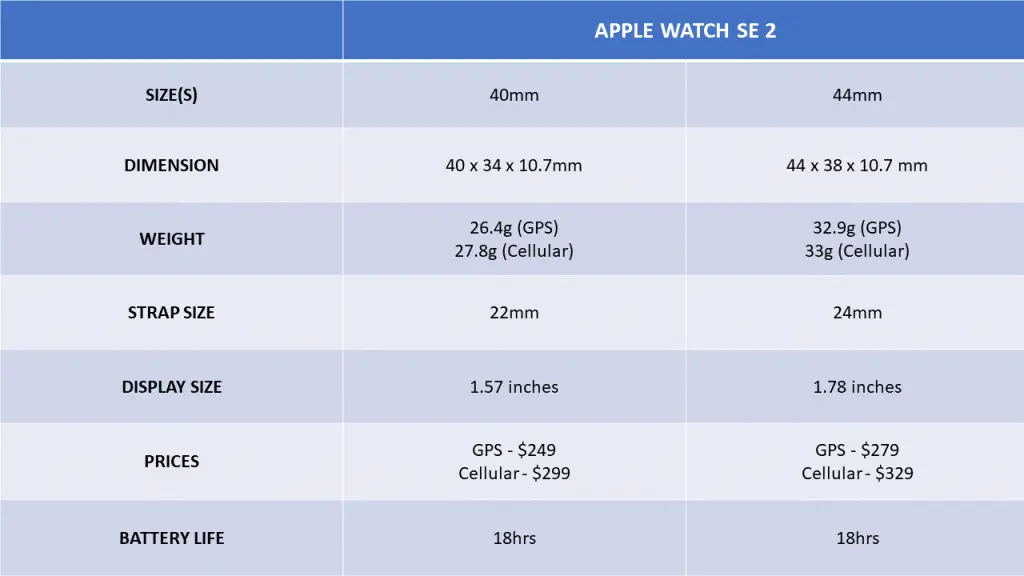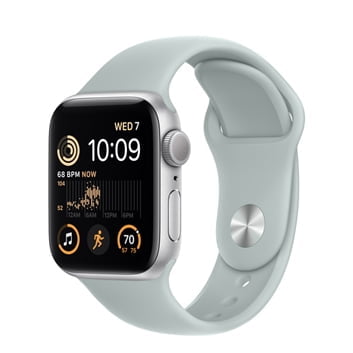The Watch SE series is a less-equipped model of the Apple Watch that debuted in 2021. It now has a successor in the Watch SE 2 which like its predecessor lacks an always-on display, fast charging, and can’t track blood oxygen and ECG. Moreover, the SE 2 also lacks the new temperature sensor present in the Watch 8 and Ultra. Though it welcomes a more powerful 256-g accelerometer that can detect when your car has crashed. Meanwhile, like its predecessor, the Watch SE 2 only comes in aluminum build and is available in two sizes; 40mm and 44mm. Each of these sizes is available in GPS-Only and Cellular models. In today’s guide, I’ll tell you the differences between the 40mm and 44mm and also help you choose the right size for you.
40mm or 44mm – Which Size is Right For You?

Although the Watch SE 2 is a lower-end Apple Watch, it’s still a very fantastic smartwatch. It’s durably built and equipped with a lot of health tracking features, 32GB storage, a speaker, a microphone, and Apple Pay.
The right size for you totally depends on your wrist size. Take a measurement of your wrist using a meter rule then compare it with the size of the two watches. The one that is nearer to your wrist size would make a perfect match. You obviously don’t want a watch that sits awkwardly on your wrist. For instance, my wrist measures 45mm, so I would settle with the 44mm unit.
Apple Watch SE 2 (40mm) vs (44mm) Full Specifications Comparison
[yith_woocompare_table products=”8356,8349″]
Watch SE vs SE 2 – What’s New?
Before we continue, you need to know what’s new on the SE 2 to help you decide if an upgrade is a worthwhile option. To be very frank with you nothing much has changed with the release of the Watch SE 2. Moreover the latest OS, the WatchOS 9 can also be downloaded and installed on the Watch SE, thus allowing you to get access to all of its new features. Like the Watch SE, the Watch SE 2 is equipped with 32GB storage capacity, a speaker, a microphone, and loads of health tracking features.
In other words, the Watch SE 2 has the same features as Watch SE except for the following few additions.
- Watch SE 2 weighs a little less
- Watch SE 2 features crash detection
- Watch SE 2 has a more advanced chipset
- Extended battery life with reduced frequency of heart rate tracking and GPS readings
- Watch SE 2 has Bluetooth v5.3
While the Watch SE 2 has a similar dimension to the Watch SE, it weighs a little less. You will feel more comfortable wearing the Watch SE 2, though the Watch SE is also very lightweight.
The Watch SE has an accelerometer, however, the Watch SE 2 has a more powerful 256-g accelerometer that supports crash detection. If you own a car, this feature can be a lifesaver for you as it will allow the watch to start a call when a crash occurs and you’re unresponsive after 60 seconds. Note that while you don’t need your iPhone to make a call with the Cellular mode, the GPS/Wi-Fi model needs your iPhone nearby to start a call.
The Watch SE 2 is equipped with the same S8 chip that powers the Watch 8 and Watch Ultra. According to Apple, the S8 chip offers 20% faster performance than the Apple Watch SE’s S5 chip. Nonetheless, the Watch SE has a remarkable performance.
Continuous heart rate tracking is one feature that impacts the battery life of the Apple Watch. Apple has tried to address that with WatchOS 9 by reducing the frequency of heart rate tracking and GPS readings during workout activities. WatchOS 9.1 is also available for the Watch SE but this feature is restricted to Watch 8, Watch Ultra and Watch SE 2.
The Watch SE 2 is equipped with Bluetooth v5.3 while the Watch SE is equipped with Bluetooth v5.0. While this might not really be a significant difference, Bluetooth v5.3 offers faster switching between low-duty and high-duty cycles, thus being more energy efficient.
Watch SE 2 (40mm) vs (44mm) – The Differences
Now that you know what’s new in the Watch SE 2, let’s take a look at the differences between the 40mm and 44mm units. These two have the same design, 32GB storage, health features, and battery life. They are basically the same except for the differences in size and price. The aim of the two sizes is to give customers the option to choose their preferred size since we all have different wrist sizes and no size fits all.
- The 40mm unit is more compact and lighter
- The 44mm unit has a bigger display size
- The 40mm unit is cheaper
The 40mm unit being smaller is a more compact smartwatch than the 44mm model. Though, the 44mm unit is still one of the most compact watches. As a result of the smaller case size, the 40mm weighs a little less. The GPS model weighs 26.4g while the 44mm GPS model weighs 32.9g.
As a result of its bigger case size, the 44mm unit has a 1.78 inches display compared to the 1.57 inches of the 40mm unit. While you can read complications clearly on the smaller unit, a bigger display was a bigger deciding factor for me than how nice it looks on my wrist.
As a result of the bigger display size, the 44mm unit retails at a higher price than the 40mm unit. The 40mm GPS model retails for $249 while the 44mm GPS model retails for $279. So you will need to spend $30 more to get the 44mm unit.

